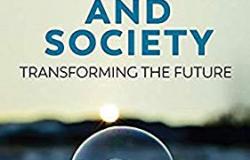Book Review – Climate and Society: Transforming the Future

Climate and Society: Transforming the Future by Robin Leichenko and Karen O’Brien. Cambridge: Polity Press 2019. 250 pp., £55 hardcover 9780745684383, £18.99 paperback 9780745684390, £12.99 e-book 9780745684420
Teaching and researching climate change can be deeply challenging and emotional with terms such as solastalgia (mental/existential distress caused by environmental change) entering recent lexicon. Navigating the grim reality of current and projected impacts with promises of ongoing action, possibilities of hope and opportunity, teachers and students alike are wondering, how do we make sense of the enormous challenges climate change poses? How can we, collectively and individually, transform in ways that are effective and inclusive? How can we motivate action while wrestling with climate denial on the one hand and increasingly devastating extreme events on the other? In Climate and Society: Transforming the Future, Robin Leichenko and Karen O’Brien, harness their expertise of examining the human dimensions of environmental change to write an engaging and invaluable book.
 At first glance, Climate and Society is an undergraduate level textbook, written in an accessible style with thought exercises and reflective questions peppering the chapters. However, collectively, the book reads as a challenge to typical climate change pedagogy. In Chapter 2, Leichenko and O’Brien give a brief yet up to date overview of climate science, the anthropogenic drivers of climate change, and what climate models project. They discuss key concepts such as carbon budgets and detection and attribution, but highlight how increasing scientific evidence alone is insufficient to motivate action. In doing so, the book moves away from typical introductory climate change textbooks and synthesises advances from geography, psychology, and the humanities to demonstrate how socio-cognitive factors like religion, norms, and values, shape risk perception and climate action.
At first glance, Climate and Society is an undergraduate level textbook, written in an accessible style with thought exercises and reflective questions peppering the chapters. However, collectively, the book reads as a challenge to typical climate change pedagogy. In Chapter 2, Leichenko and O’Brien give a brief yet up to date overview of climate science, the anthropogenic drivers of climate change, and what climate models project. They discuss key concepts such as carbon budgets and detection and attribution, but highlight how increasing scientific evidence alone is insufficient to motivate action. In doing so, the book moves away from typical introductory climate change textbooks and synthesises advances from geography, psychology, and the humanities to demonstrate how socio-cognitive factors like religion, norms, and values, shape risk perception and climate action.
These ideas are further developed in Chapters 3 and 4 where the authors discuss how different discourses around climate change highlight “differential understandings of causality and different possibilities for societal change” (p.42). Recognising the existence of different worldviews is a subtle but powerful pedagogical choice the authors make, and one that opens spaces to discuss notions of climate justice, the importance of values and norms in shaping actions, and the role of empathy and collective action. By inverting the flow of chapters – starting with worldviews, emotions, and cognitive factors (chapters 3, 4) to drivers of GHG emissions and climate change impacts (chapters 5, 6) – the authors demonstrate a different way of teaching, approaching, and understanding climate change.
In every chapter, different viewpoints are provided, which are particularly useful to students making sense of the evidence and debates around climate risks and actions. For example, when explaining the Kaya Identity, an indicator to quantifying total emissions of carbon dioxide from human sources (Chapter 5), there is also a discussion on its limits such as how it glosses over historical emissions, economies of colonisation, and outsourcing emissions.
As a climate change vulnerability and adaptation researcher myself, I particularly enjoyed chapters 8-10 which move from a comprehensive introduction to concepts of vulnerability, human security, and wellbeing (chapter 8) to discussions on maladaptation (chapter 9) and transformation (chapter 10). I was slightly underwhelmed by the discussion on maladaptation, which reports definitions from Barnett and O’Neill’s influential 2010 paper but fails to recognise more recent insights of maldevelopment potentially being maladaptive (Gajjar et al. 2019) and maladaptation as rebounding or shifting vulnerability (Juhola et al. 2016). Another minor grouse was that certain key transitions were discussed inadequately; e.g. urbanisation, one of the most significant transformations of the 20th and 21st centuries gets two pages and all the examples are from cities in the global north. However, these are minor omissions in an otherwise excellent book.
In Chapter 10 specifically, the authors make the case for transformational change towards sustainability which they describe as working across personal, political, and practical spheres. Examples of such transformations are increasing every year, from the now-worldwide Friday school strikes to Extinction Rebellion, private sector pledges towards net zero emissions, and increasing climate change lawsuits being filed. By articulating the three spheres of transformative change, Leichenko and O’Brien provide concerned people, students, and teachers a lexicon to practice climate action. They personalise the grand challenge of climate change by providing examples of transformative experiments at individual and community scales. This note of practical optimism is one of the key strengths of the book.
In Climate and Society, Leichenko and O’Brien provide interdisciplinary and critical researchers and practitioners a thoughtful and reflective pedagogical tool that skilfully manoeuvres the latest climate science and articulates future pathways for personal and societal action. In an age of growing despair, it is an evidence-based book of hope.
Chandni Singh is a researcher and faculty member at the Indian Institute for Human Settlements, in Bangalore. Her research is at the interface of climate change adaptation and development with a focus on the Global South.
References
Gajjar, S. P., C. Singh, and T. Deshpande, 2019: Tracing back to move ahead: a review of development pathways that constrain adaptation futures. Climate and Development, 11, 223–237, doi:10.1080/17565529.2018.1442793.
Juhola, S., E. Glaas, B. O. Linnér, and T. S. Neset, 2016: Redefining maladaptation. Environmental Science and Policy, 55, 135–140, doi:10.1016/j.envsci.2015.09.014.


